Sarah Sundin's Blog, page 449
December 14, 2012
Today in World War II History
70 Years Ago—Dec. 14, 1942: Allies occupy Buna village on New Guinea. On sub USS Grayback in the Bismarcks, appendectomy performed by Pharmacist's Mate First Class Harry B. Roby, 2nd of 3 such operations performed on subs in WWII.
Published on December 14, 2012 03:00
December 13, 2012
Today in World War II History
Years Ago—Dec. 13, 1942: Montgomery’s British Eighth Army launches offensive at El Agheila, Libya, takes Mersa Brega.
Published on December 13, 2012 03:00
December 12, 2012
The Advent Wreath - While Shepherds Watched...
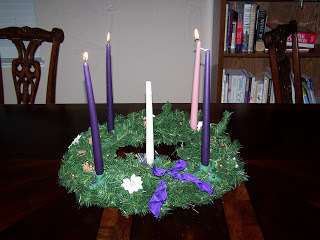 One of my family's favorite Christmas traditions is the Advent wreath. On each of the four Sundays in Advent (the four weeks before Christmas), our family gathers around the wreath with cookies and eggnog and hot chocolate. Not only is this cozy family time, but it focuses us with joyful anticipation on the birth of Jesus.
One of my family's favorite Christmas traditions is the Advent wreath. On each of the four Sundays in Advent (the four weeks before Christmas), our family gathers around the wreath with cookies and eggnog and hot chocolate. Not only is this cozy family time, but it focuses us with joyful anticipation on the birth of Jesus.This Sunday, December 16, is the third Sunday in Advent, but it's never too late to participate. If you'd like to join the Sundin family in this tradition, here are some family friendly, kid-tested ideas. Adjust these to the ages of any children present to create a meaningful time for your family.
Advent Week Three - The Shepherds' Candle
Candles:
Light two purple candles (the Prophets' Candle and the Bethlehem Candle), and the pink candle (the Shepherd's Candle). The pink symbolizes joy. Traditionally, the mother lights the candles.
Story:
Explain how the shepherds watched their flocks, heard the news that the Messiah had born, and went to see the Baby Jesus in the manger - and how they reacted with great joy.
Scriptures:
Isaiah 9:6-7 (Isaiah's prophecy of how the Messiah would be born as a child, of David's line, the Mighty God)
Luke 2:8-20 (how the shepherds heard the news and visited Jesus)
John 10:1-18 (Jesus as the Good Shepherd)
Philippians 2:1-11 (Jesus' attitude of humility, shedding his majesty to come to earth as a baby)
Songs:
"The First Noel"
"While Shepherds Watched Their Flocks by Night"
"Joy to the World"
How can your family celebrate the joy of Jesus this Christmas?
Published on December 12, 2012 04:00
Today in World War II History
70 Years Ago—Dec. 12, 1942: Germans launch offensive in attempt to relieve encircled troops at Stalingrad. UCLA beats USC for the first time, 14-7; game also included war bond drive which raised over $2 million dollars (Article on UCLA Alumni Association website)
Published on December 12, 2012 03:00
December 11, 2012
Today in World War II History
70 Years Ago—Dec. 11, 1942: “Cockleshell Heroes” Raid: British commandos canoe up Gironde River in France, blow up 5 ships in Bordeaux, 2 of 10 commandos survive. First US military personnel arrive in Iraq & Iran.
Published on December 11, 2012 03:00
December 10, 2012
Christmas in World War II - The Military
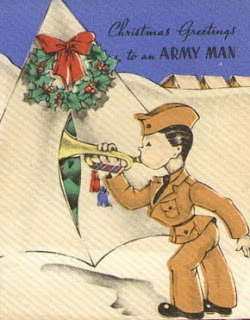 Although World War II did not take a holiday, Americans at home and abroad did their best to celebrate Christmas. Wartime separations and deprivations made festivities poignant and bittersweet. This week’s post looks at Christmas for American servicemen and women, and next week’s will look at Christmas on the Home Front.
Although World War II did not take a holiday, Americans at home and abroad did their best to celebrate Christmas. Wartime separations and deprivations made festivities poignant and bittersweet. This week’s post looks at Christmas for American servicemen and women, and next week’s will look at Christmas on the Home Front.Christmas during World War II found Americans on many fronts. In 1941, only a few weeks after the Pearl Harbor attack, American soldiers were putting up a fighting retreat in the Philippines. 1942 found soldiers fighting on Guadalcanal and New Guinea, and in Tunisia. In 1943, US forces fought on Bougainville, New Britain, New Guinea, and in Italy. Christmas of 1944 found the Allies reeling from the Battle of the Bulge in Belgium and also in France, and also engaged in northern Italy, and back in the Philippines. Throughout the war, sailors faced attacks at sea. In addition, many servicemen and women were stationed far from home even if not on the front lines.
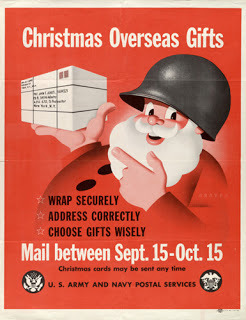 Nothing warmed the heart more than gifts from home. The Army and Navy post offices did their best to distribute presents quickly, but the sheer volume of mail and the great distances created difficulties. Families were advised to mail Christmas packages from September 15 to October 15, and the Navy restricted packages to under five pounds. Still, many servicemen, especially sailors at sea, received packages several months later. While many gifts were cherished and useful (such as candy, cookies, and warm socks), some were perplexing, such as neckties and cologne.
Nothing warmed the heart more than gifts from home. The Army and Navy post offices did their best to distribute presents quickly, but the sheer volume of mail and the great distances created difficulties. Families were advised to mail Christmas packages from September 15 to October 15, and the Navy restricted packages to under five pounds. Still, many servicemen, especially sailors at sea, received packages several months later. While many gifts were cherished and useful (such as candy, cookies, and warm socks), some were perplexing, such as neckties and cologne.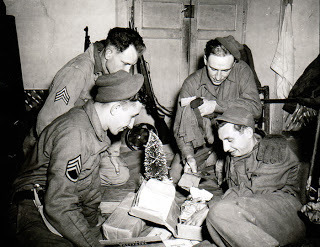 The armed services went out of their way to provide special holiday meals whenever possible. Those serving on ships or on fixed bases, either at home or abroad, had elaborate meals of turkey and ham with all the fixings. Even on the front lines, kitchens tried to provide turkey dinners. However, in 1942 on Guadalcanal, the troops were happy simply to receive an orange and a warm beer.
The armed services went out of their way to provide special holiday meals whenever possible. Those serving on ships or on fixed bases, either at home or abroad, had elaborate meals of turkey and ham with all the fixings. Even on the front lines, kitchens tried to provide turkey dinners. However, in 1942 on Guadalcanal, the troops were happy simply to receive an orange and a warm beer.Traditional decorations were scarce, but improvisation and creativity reigned. On the hospital wards overseas, nurses snipped tin from used plasma cans to make stars to string from the tent ceilings or to decorate little trees. Ration tins and foil wrappings were used for other makeshift decorations.
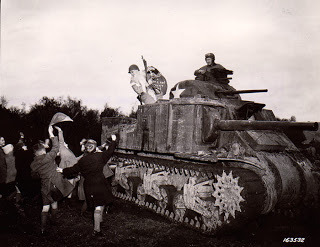 Many bases arranged Santa visits, concerts, and parties for the men. In addition, Americans often put together parties for local children. For example, the airmen of the 94th Bombardment Group stationed in Bury St. Edmunds threw a big party for British orphans.
Many bases arranged Santa visits, concerts, and parties for the men. In addition, Americans often put together parties for local children. For example, the airmen of the 94th Bombardment Group stationed in Bury St. Edmunds threw a big party for British orphans.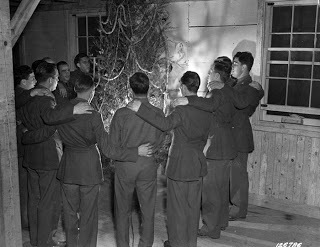 Most of all, the perilous times reminded the serviceman and woman of the reason for Christmas, the birth of Jesus Christ, who saves us from our sins and will one day usher in a new heaven and a new earth without hate and death. Christmas services were held on all fronts, and the carols about “peace on earth, goodwill to men” were sung with special fervor.
Most of all, the perilous times reminded the serviceman and woman of the reason for Christmas, the birth of Jesus Christ, who saves us from our sins and will one day usher in a new heaven and a new earth without hate and death. Christmas services were held on all fronts, and the carols about “peace on earth, goodwill to men” were sung with special fervor.Being separated from family and friends during the holidays made war that much more difficult for those in the military, but creativity and generosity made Christmas meaningful and memorable.
Published on December 10, 2012 04:00
Today in World War II History
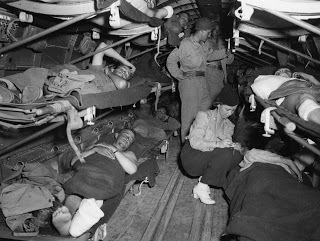 802nd Medical Air Evacuation Transport Squadron, Sicily, July 194370 Years Ago—Dec. 10, 1942: Germans strike at Medjez el Bab, Tunisia, fail to take town. The first Medical Air Evacuation Transport Squadrons (the 801st-806th) are activated at Bowman Field, Kentucky.
802nd Medical Air Evacuation Transport Squadron, Sicily, July 194370 Years Ago—Dec. 10, 1942: Germans strike at Medjez el Bab, Tunisia, fail to take town. The first Medical Air Evacuation Transport Squadrons (the 801st-806th) are activated at Bowman Field, Kentucky.
Published on December 10, 2012 03:00
December 9, 2012
Today in World War II History
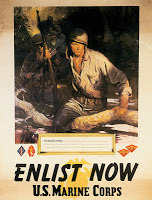 70 Years Ago—Dec. 9, 1942: US Marines under Lt. Gen. Alexander Vandegrift turn over operations on Guadalcanal to US Army under Maj. Gen. Alexander Patch. Thurleigh Airfield, home of the US 306th Bomb Group, becomes the first British base officially turned over to the US Army Air Forces.
70 Years Ago—Dec. 9, 1942: US Marines under Lt. Gen. Alexander Vandegrift turn over operations on Guadalcanal to US Army under Maj. Gen. Alexander Patch. Thurleigh Airfield, home of the US 306th Bomb Group, becomes the first British base officially turned over to the US Army Air Forces.
Published on December 09, 2012 03:00
December 8, 2012
Today in World War II History
70 Years Ago—Dec. 8, 1942: Gen. Hans-Jürgin von Arnim replaces Gen. Walther Nehring over German forces in Tunisia. Germans disarm French in Tunisia and seize ships.
Published on December 08, 2012 03:00
December 7, 2012
Remember Pearl Harbor!
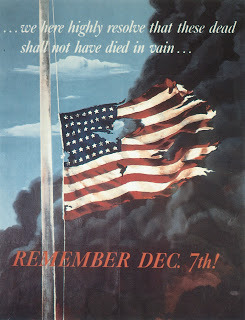 Seventy years ago, on December 6, 1941, twelve B-17 Flying Fortresses left Hamilton Field, north of San Francisco, bound for their new station on Mindanao in the Philippines. My great-uncle, Roderick M. Stewart, served as a second lieutenant on one of the crews.
Seventy years ago, on December 6, 1941, twelve B-17 Flying Fortresses left Hamilton Field, north of San Francisco, bound for their new station on Mindanao in the Philippines. My great-uncle, Roderick M. Stewart, served as a second lieutenant on one of the crews.The first leg of their journey would take them to Hickam Field in Honolulu. Weighted down by gasoline for the thirteen-hour flight, they were unable to carry ammunition. But why would they need it? The United States of America was at peace.
When the B-17s neared Hawaii the next morning, they were pleased to see fighter planes approach - to escort them to the landing field, they assumed. Imagine their shock when the fighters opened fire on them! When the fighters careened past and the Americans saw the red circles on the planes! Japanese Mitsubishi Zeros. The United States of America was no longer at peace.
The twelve unarmed bombers dodged both enemy bullets and friendly antiaircraft shells and landed where they could on fields cratered by bombs. Eight landed at Hickam Field, two at Haleiwa Field, one at Bellows Field, and one put down on Kahuku Golf Course. One of the planes was destroyed, and three were damaged. Six men were wounded, and one man was killed.
Lt. Rod Stewart emerged unscathed, served illustriously in the Army Air Force, and lived a long life. However, over 2400 Americans lost their lives that day.
The horrific results of the "Date That Will Live in Infamy" still shock us, as they should. The cost of unpreparedness must never be forgotten. We commemorate those who gave their lives for their country, not even knowing that country was at war, and give thanks for the millions who fought to end that war.
Never take freedom for granted.
Published on December 07, 2012 04:00



